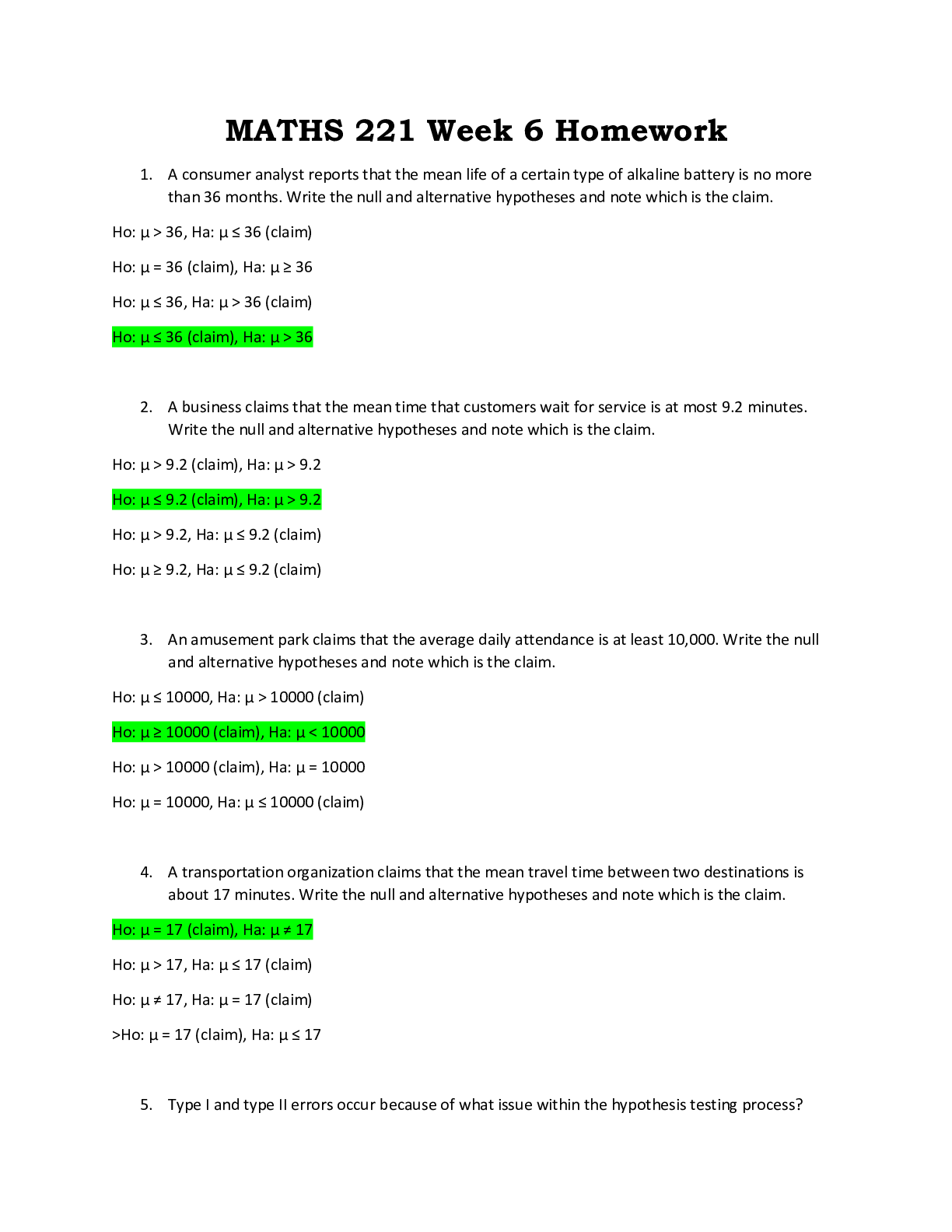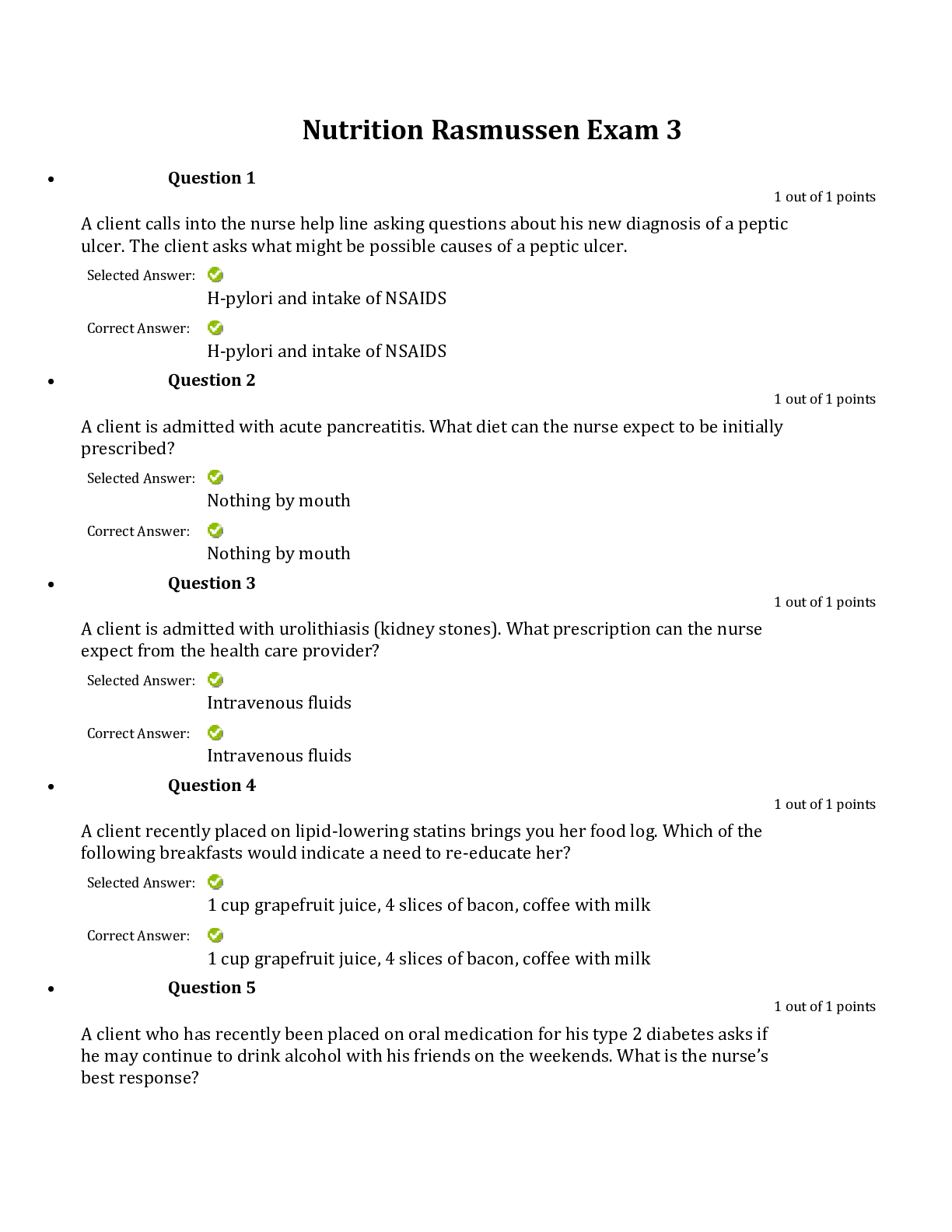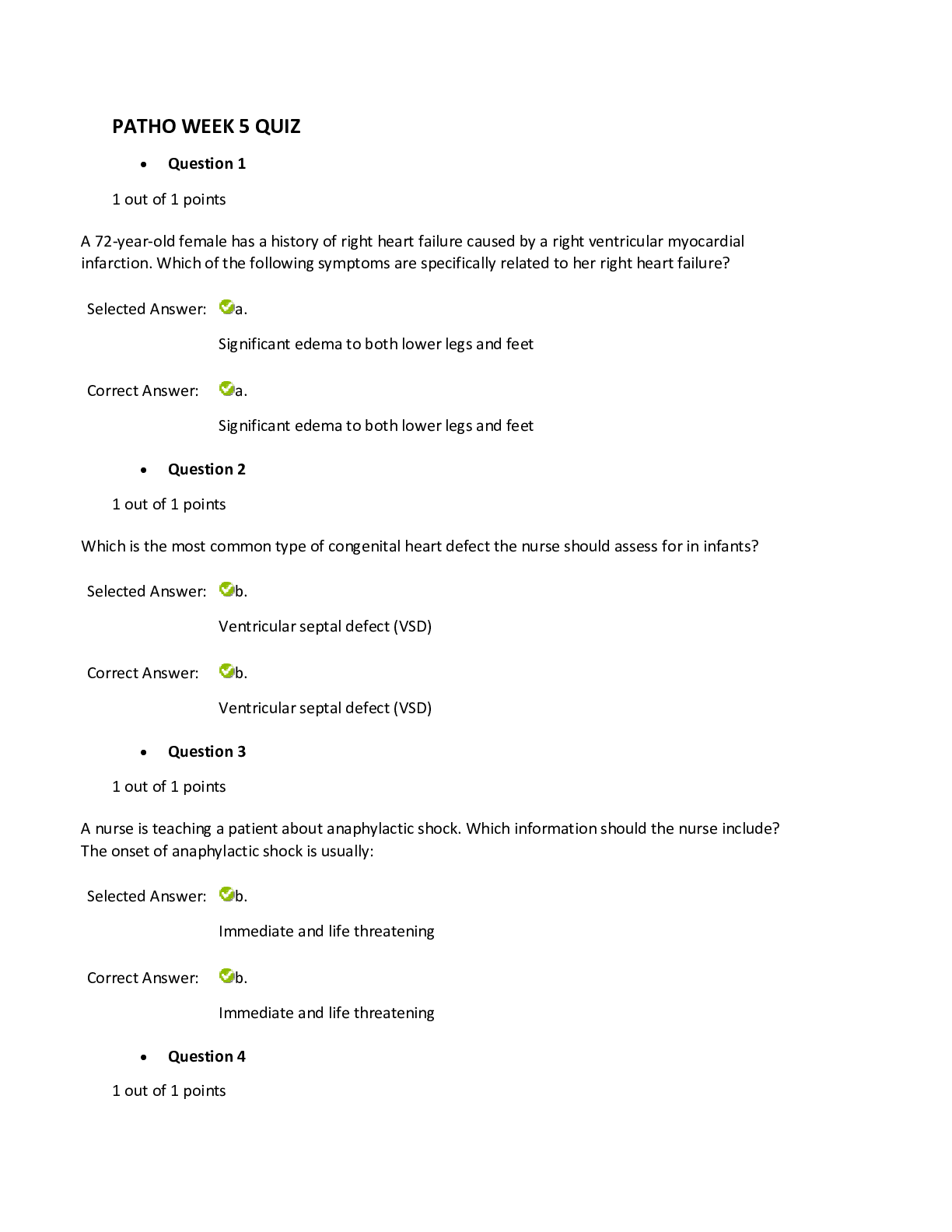Health Care > QUESTIONS & ANSWERS > NSG 6430 FINAL 6430 WOMEN’S FINAL [2020/2021] Graded A SOUTH UNIVERSITY Completed for 2022/2023 (All)
NSG 6430 FINAL 6430 WOMEN’S FINAL [2020/2021] Graded A SOUTH UNIVERSITY Completed for 2022/2023
Document Content and Description Below
Women’s Health Final Question 1 (2.5 points) The nurse practitioner knows that a highly valuable assessment tool for evaluating urinary incontinence and contributing factors in daily life is: ... B) a voiding diary Question 2 (2.5 points) The nurse practitioner is counseling a 57 year-old patient with urinary incontinence. The patient desires to try non-pharmacological, non-invasive methods of treatment at this time. Which of the following should be included in the patient's plan of care? Select all that apply. Bladder training Kegel exercises Eliminate caffeine and alcohol consumption Question 3 (2.5 points) The nurse practitioner is performing a bimanual exam on a new OB patient and notices that the lower portion of the patient’s uterus is soft. This is known as: A) Hegar's Sign Question 4 (2.5 points) Your female patient presents for vaginal discharge with an odor, and has noticed painless “bumps” on her vaginal area. Sexual history includes past male partners and her current female partner. On exam you note beefy red papules and an ulcerative lesion on her vulva, granular tissue and scarring, and inguinal adenopathy. You suspect she has: B) Granuloma Inguinale C) Chancroid (Correct ?) Question 5 (2.5 points) The physical examination of any woman suspected of being abused or battered includes all of the following except: C) a focus on the patient's physical appearance, not her behavior Question 6 (2.5 points) The most effective means of obtaining the history of abuse is to use a communication model that: D) allows the patient to talk without interruption and with time to relate, emphasize, and repeat her full story Question 7 (2.5 points) Clinicians should routinely consider intimate partner violence (IPV) as a possible diagnosis for women who present with all of the following except: B) denial of any physical health problems Question 8 (2.5 points) The factors that enable women to enjoy and control their sexual and reproductive lives, including a physical and emotional state of well-being and the quality of sexual and other close relationships, make up a woman's: A) sexual health Question 9 (2.5 points) Which one of the following is not among the ways clinicians can provide a welcoming, safe environment for Lesbian, Gay, Bixsexual, or Transgender (LGBT) patients? C) Ignore the sexual status or gender identity of all patients. Question 10 (2.5 points) Which one of the following is the definition of the term "gender identity"? B) A self-label, regardless of biologic or natal sex Question 11 (2.5 points) Which one of the following statements about sexually transmitted infections (STIs) is false? A) Lesbians are at very low risk for development of STIs and vaginal infections. Question 12 (2.5 points) Among the midlife health issues of women, the number one cause of mortality in the United States is: B) cardiovascular disease Question 13 (2.5 points) Lifestyle approaches to manage menopause related vasomotor symptoms include: Question 13 options: B) avoiding spicy foods, hot drinks, caffeine, and alcohol Question 14 (2.5 points) The standard for managing moderate to severe menopausal symptoms is: Question 14 options: D) prescription systemic hormone products, such as estrogen and progestogen Question 15 (2.5 points) The nurse practitioner is managing an adolescent with a 4 cm functional ovarian cyst that was confirmed on a recent ultrasound. What plan of care should be anticipated for this patient? C) Repeat ultrasound in 2 months Question 16 (2.5 points) Non-pharmacologic therapy for chronic pelvic pain includes the following: Select all that apply. B) Physical therapy C) Aerobic and nonaerobic exercise Question 17 (2.5 points) The nurse practitioner understands that all of the following organisms are responsible for infection of the Bartholin's gland except: Klebsiella (Correct ?) Staphylococcus aureus Question 18 (2.5 points) Treatment of a large, symptomatic Bartholin's cyst includes all of the following except: Topical corticosteroids Question 19 (2.5 points) A 44 year-old African American female presents with complaints of menorrhagia x 15 months. Pelvic ultrasound confirms the presence of a large intramural leiomyomata. The nurse practitioner should discuss all of the following options with the patient except: Estrogen therapy Question 20 (2.5 points) The nurse practitioner is treating a patient with Elimite for scabies. The proper instructions to the patient should include: Apply to all areas of the body from the neck down, wash off after 8 to 14 hours, then repeat treatment in one week Question 21 (2.5 points) The nurse practitioner understands that the proper management of an asymptomatic woman with a small fibroid should include: Reassess in 6 to 12 months. Question 22 (2.5 points) The nurse practitioner is teaching a patient about pediculosis. Which of the following statements by the nurse practitioner is correct? “The condition is treated with Permethrin cream.” D) Trichomonas vaginalis Question 56 (2.5 points) Karen was diagnosed with trichomoniasis by her primary care provider and treated with: A) Metronidazole 500 mg po BID x 7 days (If single-dose metronidazole treatment fails and reinfection is excluded, metronidazole 500 mg orally twice a day for 7 days should be prescribed.) this is the correct answer if first treatment doesn’t work Question 57 (2.5 points) A 24-year-old woman presents with a 1-week history of thin, greenish yellow vaginal discharge with perivaginal irritation. Physical examination findings include vaginal erythema with petechial hemorrhages on the cervix, numerous white blood cells, and motile organisms on microscopic examination. These findings most likely represent: B) trichomoniasis Question 58 (2.5 points) For patients needing topical treatment for vulvovaginitis caused by Candida albicans, the nurse practitioner will prescribe: B) clotrimazole cream Question 59 (2.5 points) The nurse practitioner understands that women with bacterial vaginosis typically present with: D) malodorous discharge Question 60 (2.5 points) The U.S. Preventative Services Task Force (USPSTF) recommends ____________ of folic acid supplement daily at least one month before conception for all women with average risk for neural tube defects. B) .4 to .8 mg Question 61 (2.5 points) The American College of Obstetrician & Gynecologists recommend that all pregnant women be offered aneuploidy screening before 20 weeks gestation. This test identifies women whose fetuses are at increased risk for which of the following? Select all that apply. B) Trisomy 13 C) Trisomy 18 D) Trisomy 21 Question 62 (2.5 points) An important part of patient education for the patient with bacterial vaginosis who is receiving a prescription for oral Metronidazole is: Avoid alcohol for 48 hours after completing medication. Question 63 (2.5 points) For the patient with chronic bacterial vaginosis, the nurse practitioner will prescribe: D) Metronidazole gel .75% vaginally 1-2 times a week for 4 to 6 months Question 64 (2.5 points) The nurse practitioner's exam findings on a patient with vaginal Candidiasis is positive for all of the following except: C) vaginal ph of 7 Question 65 (2.5 points) A woman arrives at the clinic for a pregnancy test. Her last menstrual period (LMP) was February 14, 2017. Using Nageles Rule, what is the client's expected date of birth (EDB)? C) November 21, 2017 Question 66 (2.5 points) Which documentation on a woman's chart on postpartum day 14 indicates a normal involution process? C) Fundus below the symphysis pubis and nonpalpable Question 67 (2.5 points) The nurse practitioner understands that the hormone, __________, remains elevated in breastfeeding women in the postpartum period. C) Prolactin Question 68 (2.5 points) The nurse practitioner is recommending daily Calcium supplementation of ___________ to her female patients that are older than 50 years of age. C) 1200 mg Question 69 (2.5 points) Osteoporosis is diagnosed when the patient's bone density is more than ______ standard deviation(s) below the average bone mass for women younger than 35 years old. C) 2.5 Question 70 (2.5 points) Based on the latest ACOG guidelines, the nurse practitioner understands that the recommended time to initiate screening for cervical cancer in women is: C) at age 21 years Question 71 (2.5 points) The nurse practitioner understands the following lifestyle approaches may be used to prevent osteoporosis after menopause: Select all that apply. Limit alcohol intake Performance of regular weight-bearing activities Adequate calcium &vitamin D intake Question 72 (2.5 points) What is the primary role of a nurse practitioner in the research process? B) Collecting data for other researchers Question 73 (2.5 points) Whether you order diagnostic testing or refer the patient to an HIV-specific facility, laboratory confirmation is rendered. The test confirming HIV infection is _____________. A) Western blot assay Question 74 (2.5 points) The nurse practitioner is examining a twenty-nine-year-old female with a three day history of dysuria and urinary frequency. On examination, the patient is positive for suprapubic tenderness and negative for costovertebral angle (CVA) tenderness. This most likely represents which of the following? B) Cystitis Question 75 (2.5 points) A patient has been diagnosed with trichomoniasis. Which of the following single dose medications would be the best option? D) Metronidazole 2 g Question 76 (2.5 points) When educating patients about the use of combination oral contraceptive medications, they should be advised that pregnancy is prevented primarily by ____________. C) ovulation suppression Question 77 (2.5 points) A twenty-four-year-old female presents to the office with a complaint of a “yucky” vaginal discharge. On exam, a milky vaginal discharge is noted. A wet mount preparation reveals a positive whiff test and 75% clue cells. There were no trichomonads or WBCs visualized. Which of the following would be the most likely diagnosis in this patient? A) Bacterial vaginosis Question 78 (2.5 points) A fifty-five-year-old postmenopausal female patient presents with pain in the upper outer quadrant of her left breast for over one month now. The best course of action would be to _______. D) perform a breast examination and order a mammogram Question 79 (2.5 points) A thirty-nine-year-old female has just completed a course of Amoxicillin for the treatment of streptococcal pharyngitis. Her LMP was two weeks ago and reports that it was normal for her. On physical examination, there is some erythema of the external genitalia with a small amount of white discharge. The microscopic wet prep examination reveals few clue cells but an abundance of budding hyphae. There are no WBCs present. Considering the differential diagnoses and results of the microscopic examination, which of the following would be the most appropriate treatment? C) Fluconazole 150 mg tablet as a onetime dose Question 80 (2.5 points) A forty-nine-year-old female patient presents with a chief complaint of dark, watery brown vaginal discharge. Part of the differential diagnosis includes that of cervical cancer. Which of the following best describes what might be visualized on physical examination in patients with cervical cancer? A) Ulcerated firm cervix Question 81 (2.5 points) A twenty-five-year-old female presents with vaginal irritation and discharge. On examination, the cervix is easily friable and erythematous. There is no adnexal tenderness. The wet prep (wet mount) microscopic examination reveals mobile protozoa on the normal saline slide. This most likely represents _________. A) trichomoniasis Question 82 (2.5 points) A twenty-two-year-old female presents with an initial onset of herpes simplex on the external genitalia. During the patient education, which of the following statements is most important to include? D) Symptoms of the initial outbreak of the lesions are typically worse than subsequent outbreaks. Question 83 (2.5 points) Follicle-stimulating hormone (FSH) is released from the anterior pituitary gland and is responsible for which of the following normal physiologic response of the female menstrual cycle? B) Stimulation of ovarian follicles Question 84 (2.5 points) A thirty-two-year-old patient comes in for a workup of infertility. During the history, the nurse practitioner suspects that the patient may be experiencing anovulatory cycles. In order to confirm ovulation, which of the following tests would be most appropriate to order? B) Basal body temperature Question 85 (2.5 points) A nurse practitioner is performing a wet mount with potassium hydroxide (KOH) to assist with a diagnosis in a woman experiencing vaginal discharge. Which of the following would this confirm? C) Candidiasis Question 86 (2.5 points)A nurse practitioner is completing a speculum exam on a female patient. Which of the following findings would be considered a normal surface characteristic of the cervix? D) Irregular, granular surface with red patches Question 87 (2.5 points) There are several phases to the menstrual cycle. What phase begins with menses cessation and ends with ovulation? C) Proliferative phase Question 88 (2.5 points) A nurse practitioner is participating in a women’s health fair. When educating the women about risk factors for breast cancer, which of the following statements is incorrect? D) Fibrocystic breast disease Question 89 (2.5 points) The first line treatment of severe menstrual cramps that have been occurring for four months in a patient with primary dysmenorrhea includes which of the following? B) Ibuprofen Question 90 (2.5 points) Which of the following choices represents a disorder of the reproductive tract that causes pain, erythema, dyspareunia, and a perineal mass? B) Bartholin’s cyst Question 91 (2.5 points) A woman is concerned that she may develop breast cancer and is discussing her concerns with the nurse practitioner. Which of the following is not an associated risk factor for this? A) Late menarche Question 92 (2.5 points) A sixty-one-year-old thin, Caucasian female presents to your practice for a well-woman examination. She remarks that she feels like she is shrinking over the past year, despite keeping active and incorporating sources of calcium in her diet. Which of the following is not a risk factor for osteoporosis? A) Excessive exercise Question 93 (2.5 points) A thirty-five-year-old woman, presents with a six-month history of hypermenorrhea, backache, and pelvic pressure. On examination, you discover a twelve-week size uterus with irregular contour. Which of the following does this most likely represent? C) Uterine fibroid Question 94 (2.5 points) It is known that a woman who is menopausal has an increased risk of heart disease. Which of the following lipid changes occur with estrogen withdrawal in menopause? D) Decrease in HDL with an increase in LDL and triglycerides Question 95 (2.5 points) Which of the following is true regarding education of a forty-two-year-old woman diagnosed with a uterine myoma? B) Myomas will decrease with the withdrawal of estrogen. Question 96 (2.5 points) Sheryl, a seventeen-year-old, complains of a vaginal discharge for the past month. When she wipes after urinating, there is "white stuff" on the tissue. Sheryl denies urinary problems but has had some genital itching, but no odor. She also denies sexual activity. Her vaginal discharge is most likely a result of ______. A) a yeast infection Question 97 (2.5 points) Urinary tract infections are commonly seen in primary care. A twenty-five-year-old female presents with a new onset of dysuria and suprapubic pain for the last twenty-four hours. The examination reveals only mild tenderness without any peritoneal signs on the lower abdomen. A urinalysis reveals the presence of WBCs. The urine is sent for a culture and sensitivity. In addition to Escherichia coli one might typically expect to see the presence of which bacterium? A) Klebsiella ? C) Staphylococcus saprophyticus (I think this is correct) Question 98 (2.5 points) The pituitary gland is responsible for a variety of functions with respect to hormonal regulation and is composed of two lobes, the anterior and posterior sections. Which of the following list of hormones are secreted by the anterior pituitary gland? A) Growth hormone (GH) and thyroid-stimulating hormone Question 99 (2.5 points) The nurse practitioner is counseling a patient on the side effects associated with some birth control methods. The woman complains that she has developed acne and hirsutism while taking oral contraceptives. The nurse practitioner understands that these changes result from _____. C) increased free androgens Question 100 (2.5 points) You are meeting with twenty-two-year-old Emily to discuss birth control options. She has tried “the pill” in the past but failed to take it regularly. She is interested in depo because she only has to come in every three months for a shot. She also heard that one does not get a period on depo, and she likes the thought of that. Which of the following would be a specific consideration with depo that you would need to discuss with Emily based on her desires for a birth control method? B) Depo can cause break through bleeding up to the second or third injection [Show More]
Last updated: 2 years ago
Preview 1 out of 16 pages

Buy this document to get the full access instantly
Instant Download Access after purchase
Buy NowInstant download
We Accept:

Reviews( 0 )
$10.00
Can't find what you want? Try our AI powered Search
Document information
Connected school, study & course
About the document
Uploaded On
Aug 22, 2020
Number of pages
16
Written in
Additional information
This document has been written for:
Uploaded
Aug 22, 2020
Downloads
0
Views
92


 (Diane Pacitti etc.png)
















